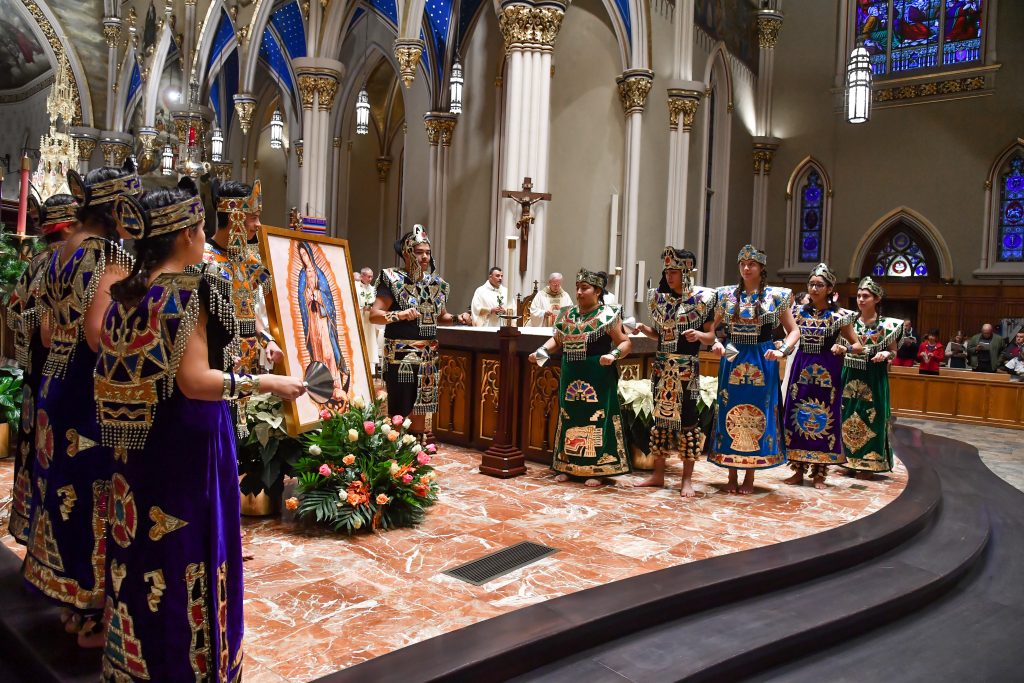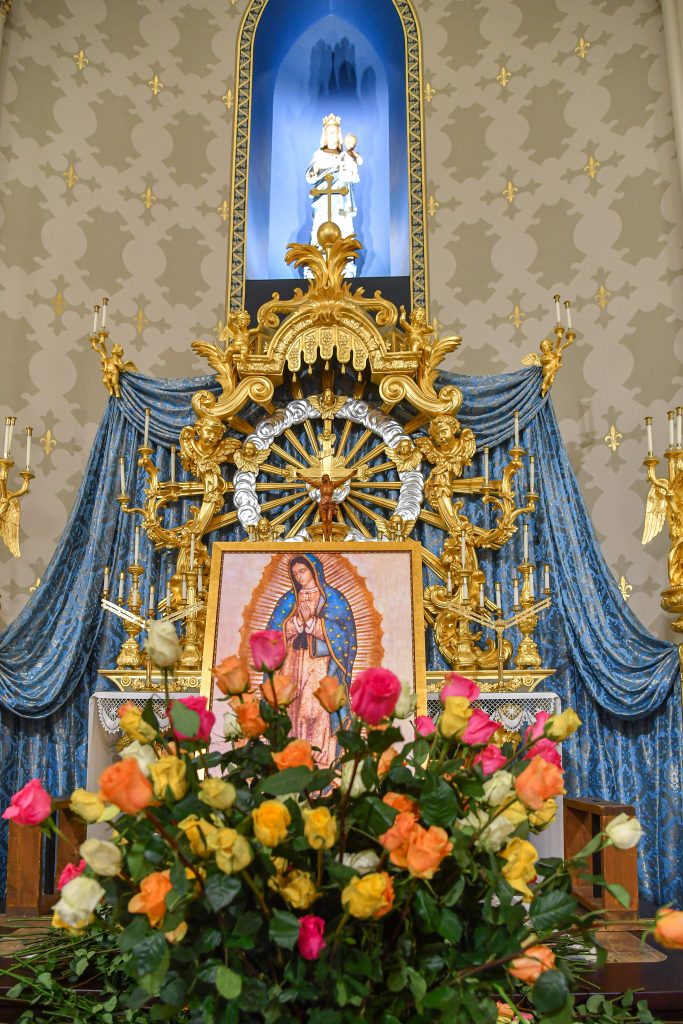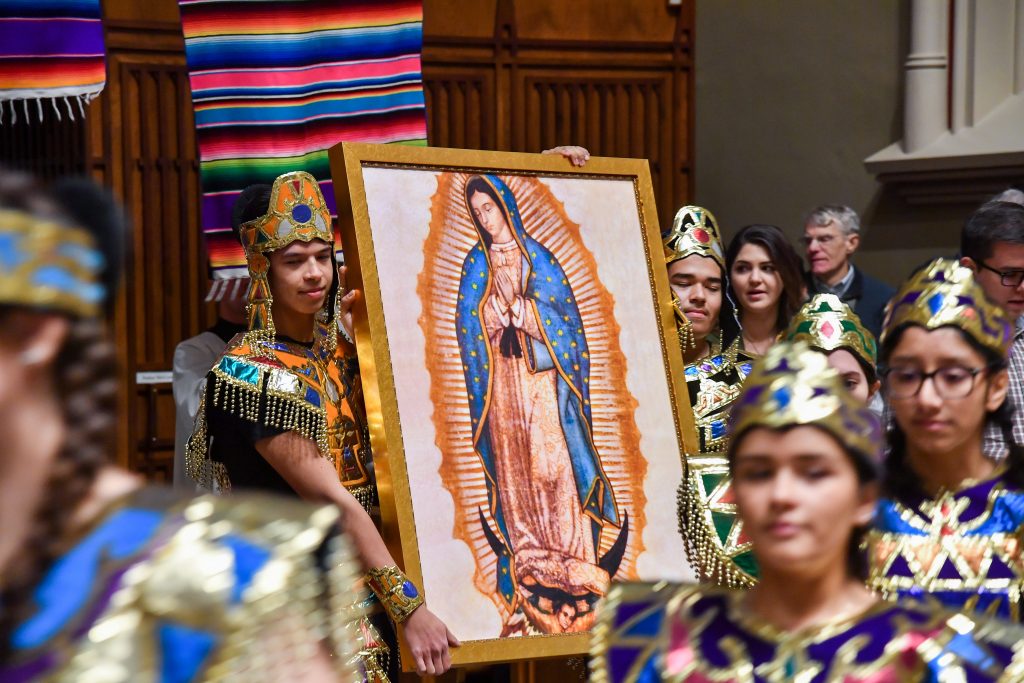December 2, 2020 // Diocese
Campus disciples sustain Guadalupe connections
Prayerful pageantry generated by the Latino student community at the University of Notre Dame will not electrify a campus congregation this Dec. 12 like it has in past years. With most of the fall semester population dispersed amid preoccupations both local and global, an internet alternative planned for that day will help maintain the close ties of faith evoked by music, ritual gestures and movement and other enduring impressions, both traditional and new.
The occasion is the feast of Our Lady of Guadalupe, whose inspiration is especially profound among Catholics from Mexico and all of Latin America. The feast’s high-energy celebration of Mass in the Basilica of the Sacred Heart has expanded as a centerpiece of fellowship among students from that vast region. It is also a chance to share cultural values across multiple boundaries.
A core message of the devotion is God’s closeness to humanity through the mother of Jesus, manifested in apparitions of Mary to St. Juan Diego on the hill of Tepeyac in 1531 and affirmed when Pope St. John Paul II proclaimed her the patroness of the Americas.

Photos by Matt Cashore/University of Notre Dame Students from the University of Notre Dame, Holy Cross College and Saint Mary’s College celebrate the feast day of Our Lady of Guadalupe in 2019 in the Basilica of the Sacred Heart, Notre Dame.
This year, the university’s Campus Ministry office plans to post a link to the streaming video of Mass at the Basilica of Our Lady of Guadalupe in Mexico City, according to Becky Ruvalcaba, assistant director for outreach.
“We hope students and alumni will seek out celebrations in their hometowns, but this is also an opportunity to enter into prayer with the world — and especially with Mexico, which has a special relationship with Notre Dame,” said Ruvalcaba, who oversees Latino ministry as well as multicultural and interreligious faith-sharing. The university’s outreach to Mexico extends back to 1850.
The number of students with roots from that country and all of Central America and South America increased in the past decade, and Ruvalcaba estimates about 200 entered as first-year undergraduates this fall.
“It’s a growing community and a faithful community,” said Ruvalcaba, who, prior to pandemic restrictions, had joined pastoral care coordinator Father Joe Corpora, CSC, in leading annual student pilgrimages to the Basilica of Our Lady of Guadalupe and Mexico City.
Many students are assumed to be “disconnected” from their religion these days, according to Ruvalcaba, but travels to Guadalupe bring hope to her and her pilgrims. “They have a desire for an encounter with a loving father; to enter into that walk with them has been beautiful, and to celebrate with them in these cultural, traditional, beautiful [liturgies] augments that love.”

An altar dedicated to Our Lady of Guadalupe is decorated for her 2019 feast day. (Photo by Matt Cashore/University of Notre Dame)
In Mexico City, South Bend and elsewhere, Latinos honor “Nuestra Señora de Guadalupe” as the Mother who came to the Americas at a time of great conflict and oppression, Ruvalcaba said. Mary entered into the story of the Indigenous people to introduce God’s mercy through Jesus present in her womb.
“That historical piece is still embedded in our hearts as Latinos,” she explained, noting that the feast helps connect students to the traditions of their families, who may be far away. They are encouraged by Juan Diego — as a model not only to receive the good news from Mary, but to accept “the responsibility to invite others in” for renewal.
Ruvalcaba believes that is part of the dynamic that has grown around the Dec. 12 Mass. Latino students take pride in organizing it as an annual liturgical highlight for Notre Dame, and it is expected to return to the basilica in 2021. They share their enthusiasm with the whole campus through a wide array of talents, using the Spanish language, cultural garb and the presentation of roses while the vivid image of the Guadalupe tilma is displayed. Those eager to respond to the experience have been known to fill every pew.
It’s a reminder that a “familia” of believers, even in new surroundings that are possibly daunting for travelers and newcomers, can feel at home in spreading their faith. “They can enter into the largeness of the Church,” Ruvalcaba said.

Matt Cashore/University of Notre Dame
Pilgrims in folkloric dress carry an image of Our Lady of Guadalupe inside the basilica.
She recalled that, as a Latina born and raised in South Bend, she came to know the beauty of Guadalupe celebrations as a child by accompanying her parents, who formed the choir for local Spanish-language Masses. Later in life, she and her husband planned a pilgrimage to Mexico with her parents. It was a first trip for all of them, resulting in joyful memories and spiritual bonding.
What’s more, Ruvalcaba prayed at the Tepeyac apparition site, thanking Mary for carrying Christ’s love. She says she felt moved to promise: “I will come back and bring your children to you so you can take them to your Son.”
She could not have imagined that today, as she enters her fifth year with the university’s Campus Ministry, she has routinely co-hosted student groups on their own pilgrimages.
Father Corpora, who co-hosts the pilgrimages, personifies the campus connections to Mexico. In his writings, which have included blogs and two books, he recalled that he first lived in Mexico City as a Notre Dame sophomore in the 1970s. His love for the country, its people and its vibrant expressions of faith have only grown: “I have traveled back at least a hundred times over the past 46 years.”
The geographical, academic and religious connections are two-way streets. Notre Dame operates a Mexico City Global Center and other activities in Latin America. On the campus, the basilica and dorms host Spanish-language Masses on a regular schedule — currently modified due to COVID-19 restrictions — and students recite the rosary in Spanish at the Grotto of Our Lady of Lourdes. Many Latinos gather for fellowship every month, and some have joined in tri-campus faith events along with Saint Mary’s College and Holy Cross College. Before leaving for home this fall, the three communities built altars to remember loved ones on the Día de los Muertos, the Day of the Dead.
Ruvalcaba said this year’s technological alternative, focusing on the Mexico-based celebration of Our Lady of Guadalupe, is the latest reflection of the connection-making for which Mary intercedes continuously, throughout the Americas and the world. Especially in tough times, she said, students and others naturally turn to their mothers, their fathers, their sources of love and hope, and their homes.
This year and every year are good times to make the course correction toward Nuestra Señora. “That’s what she is: She’s our home,” said Ruvalcaba.
The best news. Delivered to your inbox.
Subscribe to our mailing list today.






